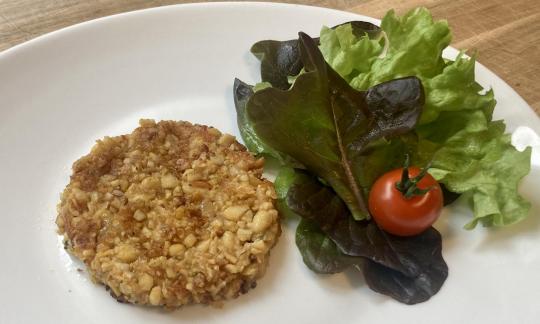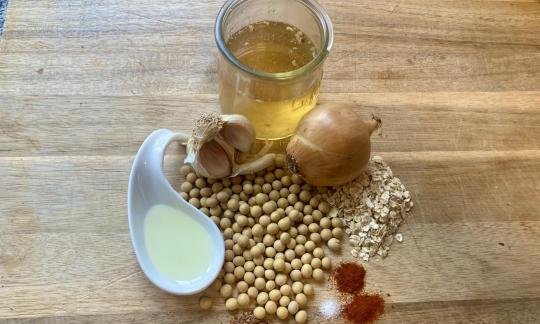Soybean patties with oat flakes, onion and garlic
vegan
Ingredients (for servings, )
| For the soybean patties | |
|---|---|
| 3 ½ oz | Soybeans, ripe seeds, raw (organic?) |
| 425 ml | Vegetable broth without added salt (organic?) (15 oz) |
| 1 small | Onions, raw (organic?) (1.6 oz) |
| 2 cloves | Garlic (organic?) (0.21 oz) |
| ½ tsp | Cayenne pepper (raw?, organic?) (0.03 oz) |
| ½ tsp | Paprika powder, sweet (raw?, organic?) (0.04 oz) |
| 1 dash | Table salt (table salt, raw?, organic?) (0.01 oz) |
| 1 oz | Oat flakes (raw?, organic?) |
| 2 tbsp | Rapeseed oil, refined (organic?) (0.98 oz) |
Equipment
- skillet (frying pan)
- stove
- saucepan
- potato ricer or potato masher
- sieve
Type of preparation
- cook
- fry
- chop or grind
- soak
- sweat
- season to taste
- remove the skin
Preparation
preparation the day before
Soak the soybeans in plenty of water for about 24 hours. Then drain and rinse. Cook the soybeans in the vegetable stock with the lid on for 60-80 minutes until they are cooked. Add a little more liquid if necessary.By using a pressure cooker you can reduce the cooking time to about 25 minutes.
In the meantime, start with the next step.For the other ingredients
Peel the onion and garlic and chop finely. Heat a little rapeseed oil in a coated pan. First, sauté the onions for about 2 minutes, then add the garlic and the spices.We used smoked paprika powder.
Finishing the patty mixture
Mash the cooked soybeans in the remaining broth (there should be very little) with a potato masher. They do not have to be finely pureed - there may still be some pieces. Add the onion-garlic mixture and the oat flakes and mix. Season to taste with salt, cayenne pepper and paprika powder. If necessary, add a little more oat flakes so that the mixture is easy to work with. Form about 6 patties from the mixture. The mixture should hardly be sticky anymore.Finishing the patties
Add the remaining oil to the non-stick pan and heat. Fry the patties on both sides until they are golden brown. Be careful when turning them as the patties break easily.
Serve while still warm.
They go well with salads, vegetables or as burgers.
|
Nutritional Information per person
Convert per 100g
|
2000 kcal | |
|---|---|---|
| Energy | 473 kcal | 23.6% |
| Fat/Lipids | 29 g | 41.0% |
| Saturated Fats | 5.0 g | 25.2% |
| Carbohydrates (inc.dietary fiber) | 33 g | 12.2% |
| Sugars | 6.7 g | 7.5% |
| Fiber | 8.5 g | 34.2% |
| Protein/Albumin | 22 g | 44.1% |
| Cooking Salt (Na:115.4 mg) | 293 mg | 12.2% |
| Essential micronutrients with the highest proportions | per person | 2000 kcal | |
|---|---|---|---|
| Prot | Tryptophan (Trp, W) | 0.35 g | 140.0% |
| Prot | Threonine (Thr, T) | 1.0 g | 108.0% |
| Vit | Folate, as the active form of folic acid (née vitamin B9 and | 212 µg | 106.0% |
| Min | Manganese, Mn | 2.0 mg | 100.0% |
| Min | Copper, Cu | 0.99 mg | 99.0% |
| Prot | Isoleucine (Ile, I) | 1.1 g | 92.0% |
| Fat | Alpha-Linolenic acid; ALA; 18:3 omega-3 | 1.7 g | 86.0% |
| Prot | Lysine (Lys, K) | 1.6 g | 84.0% |
| Prot | Leucine (Leu, L) | 1.9 g | 79.0% |
| Prot | Phenylalanine (Phe, F) | 1.2 g | 79.0% |
Detailed Nutritional Information per Person for this Recipe
The majority of the nutritional information comes from the USDA (US Department of Agriculture). This means that the information for natural products is often incomplete or only given within broader categories, whereas in most cases products made from these have more complete information displayed.
If we take flaxseed, for example, the important essential amino acid ALA (omega-3) is only included in an overarching category whereas for flaxseed oil ALA is listed specifically. In time, we will be able to change this, but it will require a lot of work. An “i” appears behind ingredients that have been adjusted and an explanation appears when you hover over this symbol.
For Erb Muesli, the original calculations resulted in 48 % of the daily requirement of ALA — but with the correction, we see that the muesli actually covers >100 % of the necessary recommendation for the omega-3 fatty acid ALA. Our goal is to eventually be able to compare the nutritional value of our recipes with those that are used in conventional western lifestyles.
| Essential fatty acids | per person | 2000 kcal |
|---|---|---|
| Alpha-Linolenic acid; ALA; 18:3 omega-3 | 1.7 g | 86.0% |
| Linoleic acid; LA; 18:2 omega-6 | 6.9 g | 69.0% |
| Essential amino acids | per person | 2000 kcal |
|---|---|---|
| Tryptophan (Trp, W) | 0.35 g | 140.0% |
| Threonine (Thr, T) | 1.0 g | 108.0% |
| Isoleucine (Ile, I) | 1.1 g | 92.0% |
| Lysine (Lys, K) | 1.6 g | 84.0% |
| Leucine (Leu, L) | 1.9 g | 79.0% |
| Phenylalanine (Phe, F) | 1.2 g | 79.0% |
| Valine (Val, V) | 1.2 g | 75.0% |
| Methionine (Met, M) | 0.33 g | 35.0% |
| Vitamins | per person | 2000 kcal |
|---|---|---|
| Folate, as the active form of folic acid (née vitamin B9 and | 212 µg | 106.0% |
| Biotin (ex vitamin B7, H) | 36 µg | 73.0% |
| Vitamin K | 43 µg | 58.0% |
| Thiamine (vitamin B1) | 0.57 mg | 52.0% |
| Riboflavin (vitamin B2) | 0.54 mg | 39.0% |
| Vitamin A, as RAE | 256 µg | 32.0% |
| Vitamin B6 (pyridoxine) | 0.36 mg | 26.0% |
| Vitamin C (ascorbic acid) | 14 mg | 17.0% |
| Pantothenic acid (vitamin B5) | 0.88 mg | 15.0% |
| Niacin (née vitamin B3) | 1.8 mg | 11.0% |
| Vitamin E, as a-TEs | 1.1 mg | 9.0% |
| Essential macroelements (macronutrients) | per person | 2000 kcal |
|---|---|---|
| Phosphorus, P | 466 mg | 67.0% |
| Potassium, K | 1'124 mg | 56.0% |
| Magnesium, Mg | 174 mg | 46.0% |
| Calcium, Ca | 184 mg | 23.0% |
| Sodium, Na | 115 mg | 14.0% |
| Essential trace elements (micronutrients) | per person | 2000 kcal |
|---|---|---|
| Manganese, Mn | 2.0 mg | 100.0% |
| Copper, Cu | 0.99 mg | 99.0% |
| Iron, Fe | 9.1 mg | 65.0% |
| Zinc, Zn | 3.3 mg | 33.0% |
| Selenium, Se | 14 µg | 25.0% |
| Iod, I (Jod, J) | 8.0 µg | 5.0% |
| Fluorine, F | 4.1 µg | < 0.1% |
The soybean patties with oat flakes, onion and garlic are a good alternative to traditional vegan patties.
Nutrient profile: According to GDA guidelines, one portion of this protein-rich dish covers the average daily requirement of the essential amino acids tryptophan and threonine and the average daily requirement of folic acid. Furthermore, at least 70% of the requirement for almost all essential amino acids, with the exception of methionine, is covered. However, some of the heat-sensitive ingredients such as folic acid are lost during the cooking process, which slightly reduces the amount per portion. The ratio of omega-6 to omega-3 fatty acids is 4:1, below the maximum recommended ratio of 5:1.
You can find further information on this topic at the following link: Vegans often eat unhealthily. Avoidable nutritional errors.
Soybeans: Soybeans are very high in protein and are therefore a good vegan protein source. The ripe seeds contain all eight essential amino acids. Only the methionine content is slightly lower compared to the other seven essential amino acids. The ripe seeds are not edible raw.
Vegetable broth without added salt: We have deliberately reduced the amount of salt by using this vegetable broth variant in order to keep the salt content as low as possible without compromising on taste. Since salt requirements vary depending on individual habits, it is best for you to decide for yourself. We would like to recommend the book " Salt, Sugar, Fat " as an interesting read on this topic.
Oils in comparison: We used refined rapeseed oil because it has a good ratio of omega-6 (LA) to omega-3 fatty acids (ALA). For comparison, olive oil has a LA:ALA ratio of 11-12:1, whereas the ratio of the two fatty acids in refined rapeseed oil is only 3:1. Cold-pressed oils are not suitable in this case because they can only be heated slightly, in the case of cold-pressed rapeseed oil up to a maximum of 120 °C, otherwise harmful substances are created. See also the following link ( cold-pressed rapeseed oil).
Vegan vegetable stock: You can also achieve a very efficient reduction in salt by using a homemade, salt-free vegetable stock. You can find our recipe at the following link: Vegan vegetable stock.
Depending on how concentrated it is, you will need to adjust the amounts accordingly. You can also always add a little more salt afterwards if necessary.
Flaxseed egg: You can add a flaxseed egg to the recipe. For each 2 portions, add 1 tablespoon of ground flaxseed to 1-2 tablespoons of warm water and allow to soak for 5 minutes. Then mix into the patty mixture.






